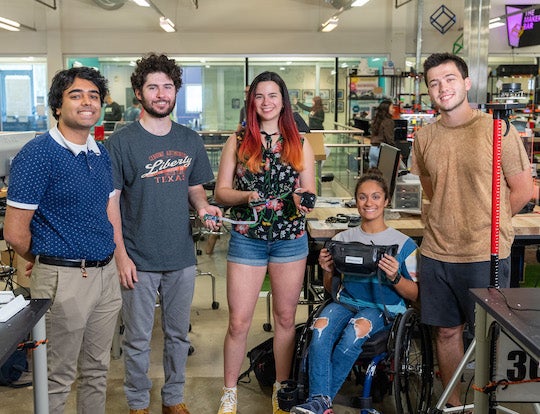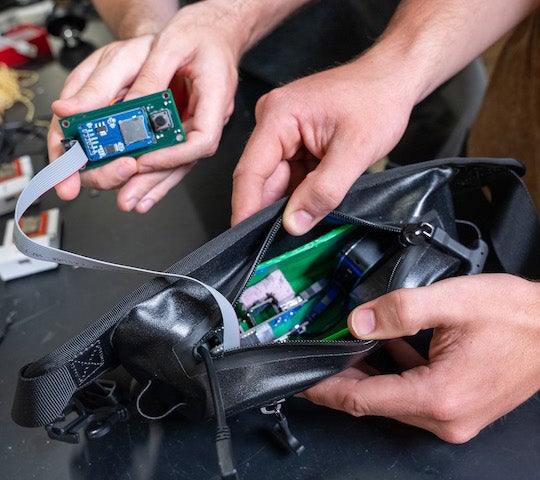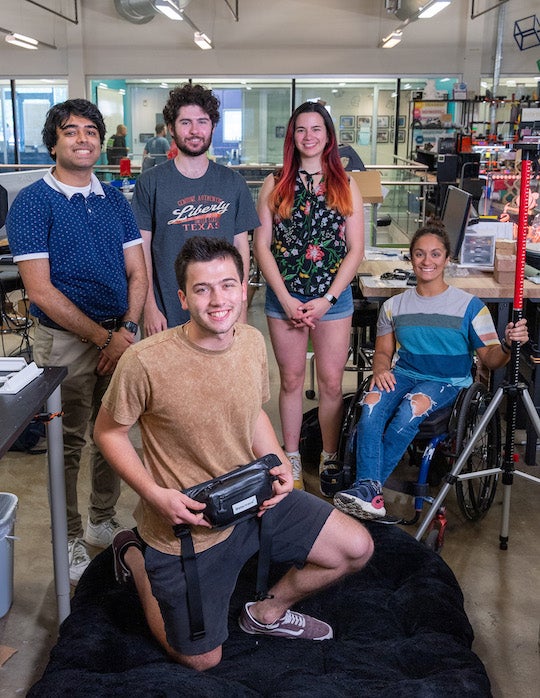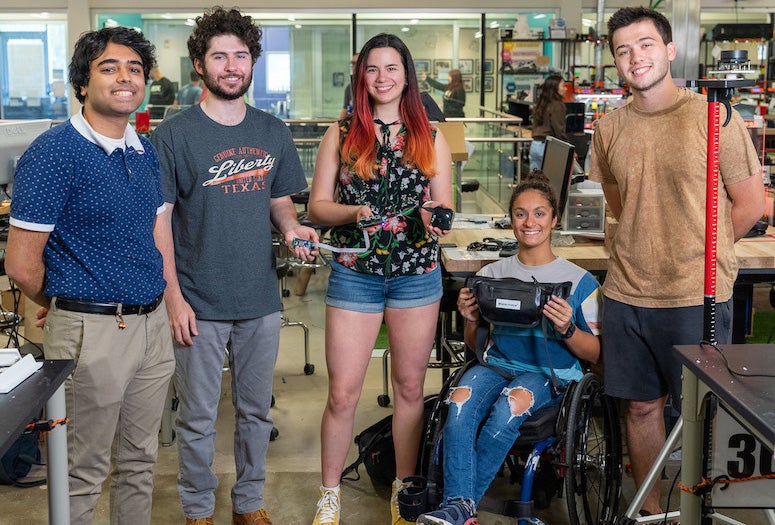Knowing how to avoid falls could help adults 65 and older fend off costly health care bills and live in their homes longer.
A team of Rice University engineering students designed a fall-risk assessment system that enables doctors to create personalized risk-management strategies for patients based on their individual movement patterns at home.

The Three Seasons team — “because with us, there is no fall,” said member Vanessa Garlepp — is one of 69 competing in this year’s Oshman Engineering Design Kitchen showcase April 13 at the Ion. Charlie Gorton, Chris Heuser, Fadeel Khan and Ahalya Lettenberger round out the team.
Falls are the leading cause of injury — and death caused by injury — for adults 65 and older, according to the Centers for Disease Control and Prevention. A quarter of the nearly 56 million adults over 65 in the U.S. experience a fall each year, and 1 in 5 falls results in serious injury such as a broken bone or head trauma.
With the population of older adults expected to reach over 85 million by 2050, the team’s fall-risk assessment system could have a significant impact in terms of reducing fall-associated health care costs and increasing patient autonomy.
The system includes a wearable device, a home-mapping and movement-monitoring component and an artificial intelligence-mediated data-processing element.

“Our wearable device tracks location with an ultrawideband sensor, it tracks movement with an accelerometer, it tracks time with a real-time clock and it has a user-input button that they can press if they are dizzy, for instance,” Garlepp said. “Lastly, everything is written to a micro SD card. That is all happening in the wearable itself. Then, the data is post-processed.”
Garlepp said she was drawn to the sensing aspect of the project: “To me, that was really cool — how the sensors would interface with each other and how everything would integrate together.
“This is also personal for me,” she added. “My grandfather actually passed away because of a fall. So I was also drawn to the project for that reason, as well as to just help prevent the same thing from happening to other families.”
The system includes a lidar scanner mounted on a tripod that can map the layout of a room, including the furniture.
“The lidar scanner sends out a signal and detects where the walls are,” Heuser said. “With the tripod, you can raise and lower it. For instance, I used it to scan my living room at different heights — 7 feet, 5 feet, 4 feet and 2 feet. And you can see features like my couch, which you can tell by the uneven line that is the cushions. Combined with the ultrawideband location sensing, this can provide physicians with a map of how a patient moves in their home and help them find the riskiest locations.”

“Our device is not only detecting falls in the home, but also detecting everything surrounding the fall ⎯ what they were doing before the fall, where they were in their home when they fell, etc.,” Lettenberger said.
“A lot of times when older people fall, they can't remember why they fell,” Gorton said. “This device gives the physician details about the fall event that a patient might otherwise forget.”
“When we spoke to our clients who are physicians, they said that most patients experience some form of either (pre-fall) activity or dizzy spell within a certain time period,” Khan said. “A patient would have to wear the device for that recommended time, because a shorter amount of time might not give you any meaningful data.”
The team’s mentors are Catherine Ambrose, a professor in the Department of Orthopedic Surgery at McGovern Medical School at UTHealth Houston and an adjunct associate professor in biomedical engineering at Rice; Dr. Nahid Rianon, a professor in family medicine and geriatric medicine at McGovern Medical School at UTHealth; David Trevas, a mechanical engineering lecturer at Rice; Sabia Abidi, a bioengineering assistant teaching professor at Rice; and Kaira Lujan, a graduate student in Rice’s Global Medical Innovations program.
- Video URL:
-
https://youtu.be/UCcuCCG8THM
(Video by Brandon Martin/Rice University) - Image downloads:
-
https://news-network.rice.edu/news/files/2023/04/230411_Three_Seasons_Team1_LG.jpg
CAPTION: (From left) Three Seasons team members Fadeel Khan, Charlie Gorton, Vanessa Garlepp, Ahalya Lettenberger and Chris Heuser. (Photo by Brandon Martin/Rice University)https://news-network.rice.edu/news/files/2023/04/230411_Three_Seasons_Team2_LG.jpg
CAPTION: Chris Heuser (front) holds the wearable device developed together with his team, (from left) Fadeel Khan, Charlie Gorton, Vanessa Garlepp and Ahalya Lettenberger. (Photo by Brandon Martin/Rice University)
https://news-network.rice.edu/news/files/2023/04/230411_Three_Seasons_device_LG.jpg
CAPTION: The wearable device and integrated in-home monitoring system aim to help doctors identify fall risk factors for individual patients. (Photo by Brandon Martin/Rice University)
- About Rice:
-
Located on a 300-acre forested campus in Houston, Rice University is consistently ranked among the nation’s top 20 universities by U.S. News & World Report. Rice has highly respected schools of Architecture, Business, Continuing Studies, Engineering, Humanities, Music, Natural Sciences and Social Sciences and is home to the Baker Institute for Public Policy. With 4,552 undergraduates and 3,998 graduate students, Rice’s undergraduate student-to-faculty ratio is just under 6-to-1. Its residential college system builds close-knit communities and lifelong friendships, just one reason why Rice is ranked No. 1 for lots of race/class interaction and No. 1 for quality of life by the Princeton Review. Rice is also rated as a best value among private universities by Kiplinger’s Personal Finance.

